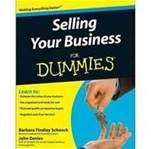
Once you start to market your business for sale, expect to receive requests for
more information. In the business sale process “more information” is not
delivered in bits and pieces and is given to serious prospects only after they sign
a confidentiality agreement. Whether your business is smaller or impressively
large, if you are selling to an unknown third party – that is, anyone who is not a
business insider, family member, or pre-identified buyer – you need to create a
selling memorandum also called a confidential business profile.
Form and Function of a Business Profile
A business profile is a booklet that provides a buyer with an initial look inside
your business. By creating a single document that you can present to all
prospective buyers, you save not only yourself the time of assembling the
information over and over again but also you are assured of telling each
prospective buyer the same story. In addition, by compiling all the information
into one convenient source rather than sharing information verbally or through
various mailing or deliveries you do not have to deal with as many buyer
questions because the buyers will have one source of information to refer to.
If you are using a broker to help sell your business the broker
will gather information to create the profile for you. If you are selling your
business on your own, make sure an attorney reviews your information before
you print final copies.
The Purpose of the Business Profile
A business profile is part business plan and part marketing brochure; it answers
the questions a buyer will have when they find out your business is for sale. It
should also preview the reasons why your business is a good purchase
opportunity. In a single document, your business profile gives buyers a snapshot
of your business history and purpose, its products, services and customers, its
operations and management, financial history, its future prospects, how much the
owner makes, what you are asking for the sale price and why you are selling.
The intention is to get buyers to take the next step.
What a business profile does and does not do:
- Provides facts but it is not a just-the-facts document. It describes theattributes that make your business attractive, along with ideas for how it can be improved and expanded in the future by a new owner.
- Emphasizes the attractiveness but does not ignore weakness. Addressyour businesses shortcomings and how they can be turned around.
- Provides an overview of what your business is and how it works but it does not try to tell everything a buyer will ever want to know.
- Presents earnings and asking price information but it does not disclose complete financial information. This summary gives a buyer just enough to decide whether they want to take the next step.
The business profile features facts about your business that are presented in a
favorable light – you are trying to sell your business, after all – but every piece of
information must be true and verifiable. The buyer will carefully check the facts
during due diligence and you will likely need to warrant the accuracy of
information provided.
The Basic Blueprint
A selling memorandum or business profile can differ from business to business
varying by length and content depending on the size and complexity of the
business being sold. The following are the components of a typical business
profile:
- The Summary: This is to give buyers an at-a-glance overview of the sale offering. It is useful for first responses to advertising inquiries because it allows you to provide a rapid response without giving to many details.
- Business Description: Identify the business name, street address, and asking price up front. Describe who, what, when, where, why and how. A prospect wants to know who you are, what kind of business you run, where it is, and why you are selling. Tell when the business was founded and by whom, list current ownership and business structure and include a positive summary of its current condition.
- Location: Geographical information is essential to include particularly if your buyer lives outside the market area. Provide regional highlights of the livability, recreation, employment advantages, business environment and growth trends. If the geographic setting is home to your business and where your customers come from – present an overview of local population in terms of income and growth rates. Highlight the advantages of the area that surrounds your location.
- Operations: This is where you tell a buyer how your business is run. Start with a sentence or two that defines what your business does, how it does it, and how it generates revenue. You will want to state the days and hours of operation and the times of the year when you do the bulk of your business. Describe any furnishings, fixtures and equipment your business owns and the fair market value of these assets. If your business has inventory, provide an approximate value and how it is priced. Specify your production or work processes especially if they are complex. Note if the business has an operations manual. Include information about how the business is structured and managed. Introduce key employees – not by names but by title and job description. Summarize any workforce issues that could affect a new buyer such as employee contracts or litigation.
- Products/Services: Explain what product or service the business sells. What makes it valuable or unique to customers? Breakdown sales into product or service categories and show how each contributes to the total sales. Include any opportunities to introduce new products or boost sales.
- Market Environment: Outline industry information such as demand or growth trends. Include the size of the industry, current market demands for industry offerings; discuss how your business adapts to industry changes, your position in the industry and how the business is configured to address challenges.
- Customers: If your business serves individual customers, describe their typical age, gender, education, household information, income and any ethnic or language information. Talk about how customers decide to buy your products or services. If you business serves businesses then describe how they make purchase decisions, whether your company is an exclusive provider and whether your relationship is protected by a signed contract.
- Marketing: Explain how your company markets itself. If your business uses mass media advertising, internet advertising or other communication methods include it. Emphasize the importance each marketing approach has to your business. List organizations in which your business participates. If your business invests heavily on marketing, mention that a complete marketing plan and budget are available for review during due diligence.
- Competition: Describe competitors by explaining their competitive attributes, weaknesses and if possible, how your business excels. Mention indirect competitors such as online sites that compete for your business. Include your point of difference that helps win customers.
- Plans and projections: List actions you believe can propel further growth or if growth is weak, recommend activities that can reverse declines.
- Financial Information: A seller’s discretionary earnings statement will show the buyer an overview of the kind of money your business generates and the profits left over. You want to give a good overview but not share sensitive information such as financial statements or tax returns until the due diligence process. You will want to describe the accounting method and whether your books are kept on cash or accrual method. Explain if you follow the calendar or use a fiscal year.
- Price and terms: State the asking price, if you will offer any seller financing, what the sale includes, qualifications of the buyer, transition plans or training, if you agree to not compete with the buyer for a certain period of time and the seller’s disclosure statement.
Tips for Making a Good First Impression
Your business profile in a way is to your business sale what a brochure is to your
product or service. You want to present the information in a way that will make
buyers want to visit your business and personally meet you. With that in mind,
pay attention to the aesthetics. Make sure it is packaged well, printed on nice
paper, free of grammar or spelling errors, and has continuity. If you are not a
writer then get help writing the business profile. Proofread for accuracy. If you are
working with a business broker, he or she will help you prepare this document or
will do it for you. Make sure to use widely understood language avoiding jargon
or insider terminology. Be honest and accurate because buyers will check the
facts and you do not want to make false inaccurate or overly optimistic
statements that may be misleading to a buyer. Be careful not to reveal
confidences. Only one prospect will end up buying your business so be careful
not to have sensitive inside information included such as trade secrets,
confidential pricing, client contracts, customer names or other details that you
would not want competitors to know.
Trading Your Business Profile for a Confidentiality Agreement
Letting the word leak out that your business is for sale is dangerous. Your sale
plans can cause employee and customer concerns and on the marketing front
competing businesses may use your sale against you. It is important to never, ever
share a selling memorandum or business profile with anyone who has not signed
a confidentiality agreement. Confidentiality agreements or non-disclosure
agreements are routine in the business world and your request will not surprise a
good buyer. You want to make sure that a prospective buyer keeps the fact that
your business is for sale a secret. When your business profile and confidentiality
agreement is ready, you are set to actively market your business for sale.




